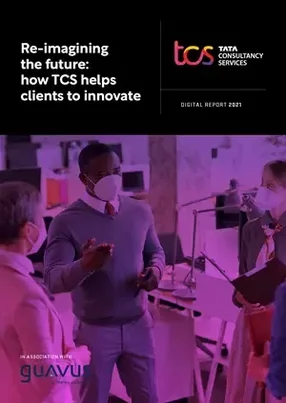Road mapping investment
However, whatever sector a customer is associated with, in today's world communications must be central to their concerns. For Antony (Tony) Kagoo, based in London and Head of Innovation for the Communication, Media & Information Services unit for TCS in the UK and Europe, innovation – keeping a step ahead of implementation and constantly re-imagining the future – is the most important part of his work. “Many organisations invest in research, of course, but I see the challenge for them as understanding where to invest most effectively to get the best returns on those investments.”
To make sure this happens, and that the most relevant and advanced thinking is brought in, TCS established its Co-Innovation ecosystem (COINTM) to leverage emerging technologies along with a global partner ecosystem. Tony Kagoo is a great evangelist for this initiative. “Within our COIN ecosystem we have 2,500 start-ups globally, venture capital firms, industry specialists and consultants, and technology alliances with the major cloud and technology companies. We also have more than 65 academic partnerships with leading universities and research institutes.” The COIN global team, he says, is focused on finding disruptive technologies in areas such as machine learning, artificial intelligence, cognitive computing, cybersecurity, Robotic Automation, Advanced Analytics and the like. “We bring these technologies on board, so the customer does not have to start the innovation journey from zero, but starts with a real head-start.”
When the pandemic struck global business in 2020, it broadly changed the way TCS customers thought about innovation. The most vital lifeline for businesses and consumers alike was connectivity, which while enabling businesses to work remotely, had not even been tested for efficacy across scenarios. “It really proved the truth of the saying, 'the fuel for disruption is disruption itself,' so the need for smart investment in relevant technology quickly came to the fore. And with people in the major economies all working from home, communication technologies were at the centre of the conversation. We've been able to help our customers to re-imagine a future, shape it, evaluate the hypothesis, understand whether what they want to do with technology actually has a value in the market, then help them to formulate a structure, a roadmap or a business case to decide the right investment options.” But if connectivity was indeed the lifeline, CSPs should have witnessed a sharp rise in revenue and profits, which unfortunately was not the case, with many stagnating and some recording a slight dip at the start of FY '21.
Gathering PACE of change
Transitioning to a Business 4.0TM mindset needs guidance if effort and investment are to be results-focused. With this in mind, TCS developed an experiential brand called TCS PACE TM. The TCS PACE TM brand was introduced as a brand identity encompassing its research, innovation and digital transformation capabilities, applied within a business framework. Tony Kagoo explains: “TCS Pace draws together our research, innovation, and digital transformation experiences for a smooth transition to Business 4.0. You could describe it as a 'client engagement arena' that channels the formidable domain expertise we've accumulated, across many decades and organisational units, into internal and external co-innovation programs”
As a practical way to access all these resources, TCS is establishing co-innovation centres, called Pace Ports, at selected regional hubs. The most recent of these, joining facilities in New York and Tokyo, is in Amsterdam. “Amsterdam will be a hub for our TCS teams to co-innovate with UK & European customers, guiding them through the discovery, definition, refinement and delivery phases of innovation. It will also give them rapid prototyping capabilities. Pace Ports have a clear focus on finding and creating sustainable solutions.”
Innovation Leadership
“At TCS we are groomed to be leaders in whatever role we play,” Kagoo explains. “One of the key aspects of my role is to define an innovation strategy integral to TCS’ growth and transformation strategy. Managing multi-stakeholders is a leadership skill essential in today’s world. Innovation leadership is key in creating a collaborative ecosystem to drive exponential value across horizontals and verticals.
“Collaborating with a larger research and innovation ecosystem to drive growth and transformation for our customer is one part of the puzzle: there are other critically important ones as well. While keeping our eyes on the big picture we should never forget that people and culture give meaning to innovation.
“Developing a culture of innovation is vital to the success of an organisation’s innovation strategy. At TCS we foster an innovation culture that is inclusive and diverse, not just in domain and technology but also in people and the roles they play. It is this embedded culture that I take to our customers as a living example during our conversations.
“To create a pervasive innovation thought-process, it is important to enable people with the right attitude and mindset. Building the next generation of innovation leadership is a key measure that I own and work at every day. The conversations we have with customers and the wider ecosystem should not be restricted to a few but there is a fundamental need for it to be pervasive and outcome focused.
“Innovation without outcomes is like running without a destination! In TCS we have embraced agile innovation at the core of how we partner with customers for Innovation. Our journey always starts with the outcome in mind. It is important to define success and failure before reaching decisions.
“Again, where there is a strategy there are always key performance indicators (KPIs). I am often asked to define the right KPIs for innovation. Measuring innovation should be rational, and transcend the normal boundaries of strategy, finance and process. KPIs should also include people and partners like: what percentage of our people who engage, participate and really come through with disruptive or creative solutions? How often do we conduct campaigns focused upon solving our customers’ problems and identifying unmet, unarticulated needs that could be a hotbed for disruption? How many partners do we engage and co-create solutions with? Identifying key measures that help us to understand the human part of our innovation strategy is an absolute must.
“As leaders it is our responsibility to enable and equip the wider organisation with right tools, processes, frameworks, knowledge and awareness to create meaningful and impactful habit-forming products and solutions for customers.”
Innovation at the heart of CSP strategy.
Communication Service Providers (CSPs) are at the cusp of industry evolution, connecting the different touchpoints in a user's journey whether they are an enterprise or a consumer, Kagoo believes. “CSPs have the power to gather data and insight on how individuals and organisations function in the connected world. This means they are best placed to create a collaborative ecosystem with partners and organisations to shape the future. One of the key trends we are observing is that enterprises in the B2B segment are constantly trying to disrupt themselves by re-imaging their business model to address a new world of consumers in the future.”
It is very clear that innovation should be part of a customer’s business strategy and align with their vision for the future. Strategy is of course a living and constantly evolving collateral, the key is execution, he believes. “One of many challenges is to break down the vision into rational pragmatic elements in the strategy that need to be positioned as part of the organisational culture and operating model.”
Disruptions are Happening on all fronts
In the last year, we have seen how the necessity for remote working has fundamentally disrupted the way business is conducted globally, and the extraordinary demands this has placed on telcos in particular. It's been no small task for them to address unanticipated demands in the short term but how might they need to change in the future?
“To understand the future, we need first to identify the forces at play; society, environment, science, technology, geopolitics and the changing economic and regulatory environment,” he says. “Understanding how these forces influence the future we foresee plays a pivotal role in identifying problem statements and market gaps. We work with our customers to identify the intersections of industry, research, technology and society, where we strongly believe the opportunities exist. We work together with customers to evaluate and prioritise the opportunities. The innovation portfolio we create will help in deciding what needs to be done today, tomorrow and the day after. Only now we are strategically poised to start the execution phase of innovation and developing roadmaps for short-term, mid-term or long-term investments. Rapid delivery of prototypes to test hypotheses will help to reduce the time to innovate. One of the ways we provide rapid prototyping is through Innovation-as-a-Service (IaaS). The as-a-service model helps customers to be on the fast track to develop solutions by leveraging the investments we have made in Research and Innovation (R&I) along with the decades of experience built across industries globally.”
For TCS innovation is not just creating prototypes, but helping customers in shaping the future, shaping problem statements, and finally delivering impactful solutions to address these problem statements.
“One of my primary jobs, conversations with a diverse set of customers who manage innovation across multiple functions in the organisation, is not just to talk about success stories but also deliberate on what did not work – why they failed. These lessons and best practices along with contextual knowledge, belief in creating a better future through impactful products and solutions, uniquely place us to collaborate and accelerate our customer’s transformation journey – underpinned by innovation.”
A good illustration of this approach is seen in the March 2021 expansion of the strategic partnership between TCS and VodafoneZiggo in the Netherlands to help the telco speed up its fixed fibre network rollout, enabling superior connectivity for subscribers and faster launch of new services. As part of the partnership, TCS is deploying AI and ML technology as well as TCS TwinXTM, its digital twin solution for enterprises. The digital twin model will help VodafoneZiggo gain a deeper understanding of its existing network infrastructure and embrace a data-driven roadmap for the rollout of its B2B fixed fibre network.
5G and essential partnerships
Technology has to have relevance, Tony Kagoo insists. Just because blockchain exists, that doesn't mean every enterprise should adopt it, but in the world of the CSPs he deals with some are clearly spearheading the conversation and it's vital for them and their enterprise customers and end-users that fast-expanding technologies like AI, blockchain, edge computing and of course 5G, are realistically considered, matched, and applied to solve specific problems. We have already seen how TCS COIN is just one platform to bring together in an agile partnership the best minds and innovators. For TCS CMI one of the key areas of collaboration with partners is in the area of 5G and networks. “As 5G matures into a more commercially viable connectivity enabler and technology, ecosystem partners will be a catalyst to unlock market potential and drive purpose-led and insightful products and services.”
5G will mature as we progress through 2021/22, he predicts. “This dynamic is already driving CSPs to start re-imagining themselves as a technology company that provides curated and contextual products to specific industries. Piggybacking on CSPs' 5G connectivity will herald a wave of partnerships that will usher in the age of ecosystem-driven businesses.”
One of the key partners Kagoo and his team are working with in this space is Guavus, a Thales company and a pioneer in the application of big data, streaming analytics, machine learning (ML) and artificial intelligence (AI). The partnership is working to solve critical operational and business challenges, and currently spearheading the development of analytics products for 5G network operators, mobile IoT applications and cloud-based digital services. “We are observing that telcos face the challenge of huge 5G investment and are keen to explore opex reduction measures. Telcos need business agility, real-time insight-driven operations such as zero-touch, that can enable the delivery of network slices seamlessly for enterprise business. At TCS we have strong consulting, advisory and system integration experience and we strongly believe our partnership with Guavus can focus on delivering customer experience and operational excellence to CSPs with the technology they bring across network domains from the 5G edge and core, to the cloud.
“As 5G increasingly gains momentum, TCS’ partnership with Guavus enables operators to deploy best-in-class Guavus 5G solutions such as 5G-IQ Network Data Analytics Function (NWDAF) and Ops-IQ which add huge value. However, in conjunction with TCS advisory, consulting and services capabilities, this means that operators can protect their existing investments and familiar processes associated with their legacy 4G and older solutions, migrate and scale them to the levels required for 5G, whilst in parallel supporting 3GPP standards compliant 5G solution. This preserves previous investment, simplifies the analytics landscape, reduces opex and organizational change, and ensures a smooth migration to 5G. Further, this provides a sound base from which to unlock the accelerated revenues and growth that 5G promises.”
Humanity makes progress through the power of its ideas and its quest to perpetually make things better, concludes Tony Kagoo. “If we peel back the layers of innovation, at the core we uncover the forces and dynamics that drive today’s world – and people like us. For several millennia, our inventions have created greater futures for humans by helping us transcend the limitations of our biology and our environment. As a species we have been able to imagine and create the world we want to live in. As individuals and as a business we have a responsibility to invent a greater future for all.”



